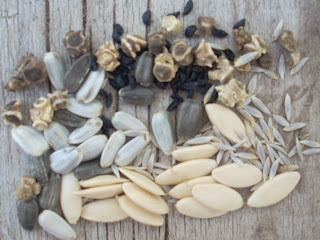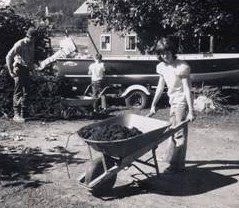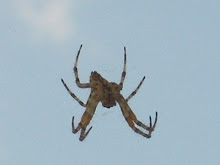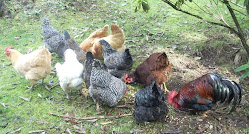
First of all may I just start by saying that I have had the privilege of experiencing many many types of pests in my yard from mighty moose to mighty slugs and as of yet have not solved the problem of eradicating them completely (and maybe I don’t want to for mother earth reasons) but along the way I have discovered a few tricks that may or may not help depending on the overall situation right at the moment the pests are being pesky.
Moose: In the Pacific Northwest Moose are not much of a problem, but in Fairbanks (where I came from years ago) moose are possibly the worst pest, because they can completely clear out every single green thing in your garden in one sitting. I see three options; grow enough for the moose and you, don’t grow anything the moose will eat (?) or electric fence.
Slugs: In Fairbanks I only ever saw one teeny tiny black slug!?! But that is not the case here in Western Washington, or in Juneau where I grew up. I remember one summer when I was 10 or so collecting hundreds of little grey slugs in a bucket that I filled with water in an attempt to drown them…they just crawled out. Many people use slug bait in liquid or pellet form which works but I don’t like to have my pets around that, so I use Sluggo which is iron phosphate and not poisonous to anything but slugs. It takes a week or so to see its affects. I don’t use Sluggo in my pots however because it can create a mineral buildup that may be harmful to the occupants. In pots, sprinkle diatomaceous earth around the plants. You can get both of these products at the hardware or greenhouse store. I also have a pair of slug snipping scissors…snipped slugs make great compost.
Deer: Deer can also eat every single green thing in your garden, like a moose but not as quickly, since they are much smaller. The same solutions mentioned in the moose paragraph apply on a lesser scale. Deer are visual so any type of barrier works such as a big board fence. They are pretty competent jumpers so the fence needs to be fairly tall. Electric fences are also effective but deer are amazingly aware of if and when it is or isn’t working. I had hoped my dog would be a good deterrent but deer who are accustomed to living in a suburban setting don’t tend to be afraid of dogs. I have heard that deer don’t like human hair, I can’t prove this but I do sprinkle the clippings around after I cut my family’s hair.
Little critters: I have trouble in the spring when bigger seeds, such as peas, beans, corn and/or sunflowers begin to germinate. Something digs them up, eats the seed and leaves the stem and root. Very annoying! Sprinkling chili pepper flakes (I get the big jug at Costco) over the dirt after the seeds are planted works pretty well. This year I am also trying plug in ultrasonic pest repellers to see if that helps in the greenhouse and near the house.
Aphids: These lovely little bugs can accumulate thick and solid before you know it on dahlias, nasturtiums, dill, maple and fruit trees to name a few. They are either green or black ovals and are often accompanied by ants that collect the “milk” or nectar the aphids produce while sucking the plant dry. Two things work. I set my hose on the hardest spray and blast the aphids off the plant. This only works for fairly hardy plants. For the more tender vegetation I spray a weak mix of soap and water from a standard spray bottle. I have also smashed many with my fingers which is kind of messy but very satisfying…I wear gloves.
Bugs that like broccoli, onions and carrots: There are flying insects that lay their eggs, in or around plants. When the eggs hatch, the larvae feast on and ruin in various ways (that might be another story for another time that I am not really willing to write because it’s too disgusting) the above mentioned plants. They are known by various names like cut worm, bud worm and root maggot. A simple way to deal with these pests is to place a row cover (very light weight cover you can get at the hardware store) over the plants or seeds when they are placed in the ground. Weigh the edges down with rocks, loosely so there is room for the plants to grow. This will prevent the flying adult insect from getting anywhere near plants to lay their eggs.
Cats and Chickens: Although you may not think that these two are related…what they can do in your flower bed, or any exposed dirt is very similar – I won’t go into any details, and as beneficial as it is to have them as pets, you don’t want them digging in your garden. Even though they can both jump I find that they don’t tend to, so I have constructed various short barriers (see sidebar) around any exposed dirt to keep them out. Also, they really prefer their dirt dry so keeping things watered helps.
Moles: Moles eat earthworms primarily and earthworms eat compost. I have a mole problem where I put compost. Moles don’t care about plants but in their digging quest for worms they uproot them. I have tried everything I can think of and have heard of to chase moles away from the garden, like car exhaust down the hole, various types of traps in the hole, stomping on the tunnels, rat poison in the holes, smoke bombs, screaming and yelling. I have not solved the problem so if you have any ideas let me know!
There are other pests I know about such as lawn mower or weed eater blight (as Colette calls it), dogs, kids, basketballs, bikes, weather, etc., but you are on your own with those. Otherwise I am always looking for pest solutions. It would be so cool, if you have any pesky pest tips -- that work -- to add them into the comments here so that we can all learn new ways to accommodate the pests who insist on pestering us – in the garden!


 First of all may I just start by saying that I have had the privilege of experiencing many many types of pests in my yard from mighty moose to mighty slugs and as of yet have not solved the problem of eradicating them completely (and maybe I don’t want to for mother earth reasons) but along the way I have discovered a few tricks that may or may not help depending on the overall situation right at the moment the pests are being pesky.
First of all may I just start by saying that I have had the privilege of experiencing many many types of pests in my yard from mighty moose to mighty slugs and as of yet have not solved the problem of eradicating them completely (and maybe I don’t want to for mother earth reasons) but along the way I have discovered a few tricks that may or may not help depending on the overall situation right at the moment the pests are being pesky.







 Everyone is asking me about gardening and with the current economic situation in our world it is a good question! “Gardening” is easy and can be an inexpensive way to relieve some of the pressure on your food budget. “Gardening” is a very broad term that applies to anything from just one pot to acres of plants. Everyone should have at least one pot worth of gardening and it is my goal that all of you have at least one pot full of tomatoes on your patio or deck this summer! Here is how:
Everyone is asking me about gardening and with the current economic situation in our world it is a good question! “Gardening” is easy and can be an inexpensive way to relieve some of the pressure on your food budget. “Gardening” is a very broad term that applies to anything from just one pot to acres of plants. Everyone should have at least one pot worth of gardening and it is my goal that all of you have at least one pot full of tomatoes on your patio or deck this summer! Here is how: 












